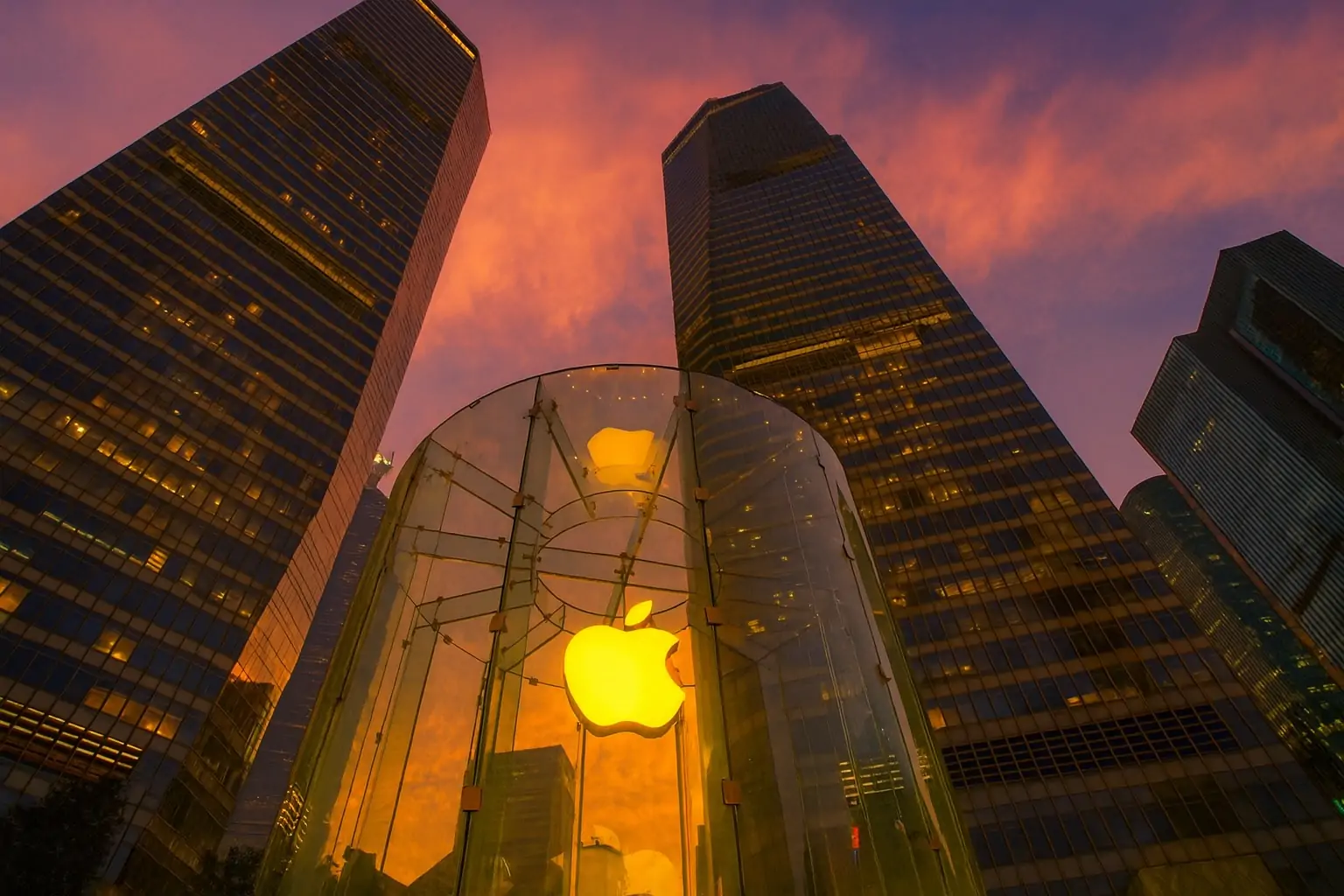Published: November 22, 2025 – Informational only, not investment advice.
Snapshot: Where Apple Stock Stands Right Now
Apple (AAPL) heads into the final weeks of 2025 trading near all‑time highs. As of late November, the stock is around $270–275 per share, within a few percentage points of its 52‑week peak around $277 and well above its 52‑week low near $169. [1]
Apple briefly joined Microsoft and Nvidia in the $4 trillion market‑cap club in late October before pulling back slightly, but it remains one of the three most valuable public companies on the planet. [2]
Over the last 12 months, AAPL has delivered roughly high‑teens total returns, outpacing major indices, while 2025 year‑to‑date gains sit in the high single digits to low double digits depending on whether you include dividends. [3]
At the same time, Apple trades at a price‑to‑earnings (P/E) ratio around 36x trailing earnings, significantly above its 10‑year average near the mid‑20s and modestly above many mega‑cap peers (though still below Nvidia). [4]
In other words: Apple is priced as a premium growth franchise. Any forecast to the end of 2025 has to weigh that expensive multiple against a powerful mix of record earnings, surging Services revenue, and a late‑cycle AI story.
Fundamentals in 2025: Back to Broad‑Based Growth
Record fiscal 2025 results
For Apple’s fiscal year 2025 (ended September 27), revenue climbed to about $416 billion, up ~6.4% year over year, while net income jumped nearly 19.5% to roughly $112 billion. [5]
The most recent quarter (fiscal Q4 2025) was particularly important for sentiment:
- Q4 2025 revenue: ~$102.5 billion, up 8% year over year
- Diluted EPS: $1.85, up about 13%
- New records: September‑quarter records for total revenue, iPhone revenue, and earnings per share [6]
Earlier, in fiscal Q3 2025 (June quarter), Apple already signaled a re‑acceleration:
- Q3 revenue: $94.0 billion, up 10%
- iPhone revenue: $44.6 billion, up about 13%
- Mac revenue: up ~15%
- Services revenue: $27.4 billion, up 13%, a fresh all‑time high [7]
These back‑to‑back double‑digit earnings gains helped Apple earn a 96 composite rating from Investor’s Business Daily, indicating it outperforms 96% of all stocks across growth and technical factors. [8]
The rise of Services and recurring revenue
Behind the headline numbers is a structural shift: Services (App Store, iCloud, Apple Music/TV+, AppleCare, Apple Pay, advertising and more) have become the profit engine of Apple.
- For the latest fiscal year, Apple is on track to generate around $108–109 billion in Services revenue, up roughly 13% year over year. [9]
- Services are estimated to account for about 25% of revenue but up to ~50% of profit, thanks to far higher margins than hardware. [10]
This mix shift matters for the stock forecast because it makes Apple’s cash flows more recurring and less cyclical, and it supports the higher‑than‑historical P/E investors are currently willing to pay.
AI, Apple Intelligence, and the OpenAI Partnership
Apple’s AI story finally gets traction
For much of the generative‑AI boom, Apple was seen as late to the party compared with Microsoft, Google, and Nvidia. [11] That narrative started to change in 2024 and 2025:
- At WWDC 2024, Apple unveiled Apple Intelligence, a privacy‑first “personal intelligence system” integrated into iOS 18, iPadOS 18, and macOS Sequoia, combining generative models with personal context on‑device. [12]
- Apple announced a deep partnership with OpenAI to bring ChatGPT into Apple’s platforms as an optional assistant for certain tasks. [13]
- With iOS 18.3 and later, Apple Intelligence features (like AI‑powered notification summaries and writing tools) began shipping by default on supported iPhones, iPads, and Macs, dramatically expanding the user base actually touching Apple’s AI stack. [14]
At WWDC 2025, Apple doubled down on this direction:
- New Apple Intelligence capabilities are coming to iPhone, iPad, Mac, Apple Watch, and Vision Pro, including deeper integration into Photos, Messages, and developer tools. [15]
- Developers gained access to Apple’s on‑device foundation model, enabling more private, context‑rich AI experiences inside third‑party apps. [16]
Analysts tracking the company say Apple is pursuing a “personal intelligence” strategy—dominating on‑device, privacy‑focused AI across billions of devices rather than competing head‑on in raw cloud model scale. [17]
AI as a driver of the next iPhone and Services cycles
Wall Street now increasingly frames Apple as a late but powerful AI beneficiary:
- Bank of America recently raised its Apple price target by $50 to $270, arguing that Apple’s AI roadmap could double annual earnings over the next five years, driven by AI‑enhanced iPhones and higher‑margin Services. [18]
- Wedbush, a long‑time Apple bull, hiked its target to $310, then $320, citing strong iPhone 17 demand and the potential $75–$100 per share upside if Apple successfully monetizes AI across its ecosystem. [19]
Apple is reportedly targeting hundreds of millions of devices with full Apple Intelligence capabilities by the end of 2025, which would create a uniquely large installed base for AI‑enabled services and apps. [20]
This AI + installed base story is central to bullish forecasts for AAPL through the end of 2025 and beyond.
iPhone 17, Hardware Trends, and the Holiday 2025 Setup
iPhone 17: Better than expected
Launched in September 2025, the iPhone 17 lineup (including the new “iPhone Air”) has so far outperformed early expectations:
- Multiple analyst checks suggest iPhone 17 sales are tracking 10–15% ahead of the iPhone 16 cycle in key markets like the U.S. and China. [21]
- Wedbush and others have cited strong demand for iPhone 17 Pro models, prompting upward revisions in production estimates and contributing to their $310–$320 price targets. [22]
That strength showed up in Apple’s numbers: Q4 2025 iPhone revenue grew about 6% year over year to just over $49 billion, helping drive the record quarter. [23]
Vision Pro and smart glasses: niche today, option value tomorrow
Apple’s Vision Pro mixed‑reality headset, launched in early 2024, remains a niche product. Sales estimates generally sit below 1 million units since launch, with demand strongest in enterprise and high‑end creator niches. [24]
More recently, Apple has reportedly paused work on a second‑generation Vision Pro to free up resources for AI‑enabled smart glasses, including a display‑less model paired with iPhones and a later, full‑display version. [25]
None of this meaningfully impacts revenue by December 2025, but it adds long‑dated optionality that some analysts bake into their more aggressive price targets.
Management’s guidance into year‑end
Following Q4 2025 earnings, Apple guided for the December (holiday) quarter to deliver the “best revenue ever” for both the company and the iPhone, with top‑line growth expected around 10–12%, ahead of prior consensus near 6%. [26]
This guidance is a key support for bullish near‑term forecasts: if Apple executes, EPS momentum continues into early 2026, making the current premium valuation easier to justify—at least through the end of 2025.
Legal, Regulatory, and Geopolitical Risks
Apple’s stock forecast isn’t just about products and AI. A growing web of antitrust and regulatory actions is a major overhang for 2025 and beyond.
U.S. antitrust suit
In March 2024, the U.S. Department of Justice and 16 states sued Apple for allegedly monopolizing smartphone markets, targeting restrictions on app developers, digital wallets, messaging, and interoperability with third‑party devices like smartwatches. [27]
In June 2025, a federal judge rejected Apple’s motion to dismiss, allowing the case to proceed in full—a clear negative from a risk standpoint, even though any remedies are likely years away. [28]
EU Digital Markets Act (DMA) and App Store changes
The European Commission has found Apple in breach of the EU’s Digital Markets Act for limiting “steering” — preventing developers from freely directing users to alternative payment or distribution channels outside the App Store. Apple was fined €500 million in April 2025 and ordered to change its rules, with additional penalties possible for non‑compliance. [29]
Apple has appealed the decision but simultaneously adjusted its pricing and App Store policies in Europe, moves that could pressure Services margins if similar rules spread globally. [30]
UK rulings and class actions
In the UK, the Competition Appeal Tribunal recently ruled that Apple abused its dominant App Store position and charged “excessive and unfair” commissions between 2015 and 2020, in a case where claimants seek over £1.5 billion in damages. [31]
Apple was refused permission to appeal that ruling at the tribunal level, though it plans to continue fighting in higher courts. [32]
At the same time, a U.S. judge recently decertified a longstanding App Store consumer class action, which is a modest legal win that slightly reduces Apple’s litigation exposure. [33]
Add to that a £4 billion UK iCloud lawsuit and fresh antitrust scrutiny, and it’s clear that regulatory risk is real but hard to quantify for the rest of 2025. [34]
AI‑related legal friction
The newer AI partnerships also bring fresh legal risk. Elon Musk’s xAI and X Corp. recently filed a lawsuit against Apple and OpenAI, alleging that ChatGPT’s integration into iPhones unfairly disadvantages rival AI apps like Grok. [35]
While early‑stage, such cases raise the possibility that Apple could face AI‑related antitrust and competition challenges in addition to its existing App Store issues.
What Wall Street Expects for AAPL Into 2025 Year‑End
Despite the crowded legal docket and elevated valuation, Wall Street remains broadly positive on Apple.
Consensus ratings and price targets
Across major data providers:
- MarketBeat: 37 analysts, average 12‑month price target around $278, with a high of $345 and a low near $170. [36]
- TipRanks: 35 analysts, average target about $289, high $345, low $225. [37]
- StockAnalysis: 29 analysts, average target $275.9, consensus rating “Buy.” [38]
- Public.com: 28‑analyst forecast for 2025 around $274.7, also with a “Buy” consensus rating. [39]
- MLQ.ai: consensus target roughly $286, again with a high near $345. [40]
Taken together, the cluster of average targets in the $275–290 range implies modest upside of only a few percentage points from current levels, but the bullish tail (targets above $300) reflects optimism about AI monetization and iPhone 17 strength.
The bull vs. skeptic split
- Bullish camp: Wedbush, Tigress and others see AAPL as a top AI and consumer platform play, highlighting its 2+ billion‑device installed base, record Services revenue, and potential upside from smart glasses and future foldable iPhones. Some targets now sit at $310–$345. [41]
- Cautious camp: Morgan Stanley and UBS have trimmed or maintained more conservative targets (around $236–$252), citing delays in advanced Siri AI upgrades, tariff risks, and concerns that current P/E multiples already bake in much of the AI upside. [42]
For the rest of 2025, most analysts expect high‑single‑digit to low‑double‑digit EPS growth, driven by the holiday quarter and Services momentum, with a strong but not explosive share‑price response unless AI adoption or iPhone demand significantly overshoots expectations. [43]
Valuation: Is Apple Too Expensive Heading Into 2026?
With a trailing P/E around 36x and a forward P/E near 32–33x, Apple trades:
- Well above its 10‑year average P/E in the mid‑20s
- Above many large‑cap tech peers like Alphabet and Microsoft, though below ultra‑high‑growth names like Nvidia
- At a valuation many data providers explicitly classify as “overvalued” versus its own history [44]
This matters for any 2025 forecast because:
- If Apple delivers or beats its double‑digit growth guidance and investors stay comfortable paying a mid‑30s multiple, the stock can likely grind higher into year‑end.
- If macro conditions worsen (higher rates, weaker consumer spending) or AI expectations cool off, multiple compression alone could pressure AAPL even if earnings hold up.
In short: execution risk is high when your valuation leaves little room for disappointment.
Scenario Paths for Apple Stock Through December 2025
These are general scenarios, not predictions or personalized advice. Real‑world outcomes can differ materially.
1. Bull case (AAPL edges toward or above $290–310)
Drivers:
- Holiday quarter revenue at or above the high end of Apple’s 10–12% growth guidance, with upside in iPhone 17 and Services. [45]
- Strong adoption of Apple Intelligence features, with early signs that users are spending more on subscription services and App Store content. [46]
- Regulatory news remains largely noise rather than immediately costly remedies. No major negative surprises from U.S. or EU cases in 2025. [47]
- Market sentiment toward AI re‑accelerates, keeping Apple’s P/E in the mid‑30s or even expanding.
In this scenario, the stock could finish 2025 near the upper band of current bullish targets, testing or surpassing levels around the high‑$280s to low‑$300s.
2. Base case (AAPL consolidates around $260–285)
Drivers:
- Apple roughly meets guidance: strong but not spectacular holiday quarter, steady Services growth, iPhone 17 demand staying healthy but not parabolic.
- Apple Intelligence rollout proceeds smoothly, but monetization is still early and modest by December. [48]
- Regulatory headlines continue, but no major fines beyond those already announced hit in 2025; investors largely look past the noise. [49]
- The broader market remains stable, with tech still in favor but more selective.
Here, AAPL might oscillate around consensus targets, ending 2025 somewhere in the mid‑$260s to high‑$280s as earnings grow into the current valuation rather than the valuation expanding further.
3. Bear case (AAPL retreats toward $230–250)
Drivers:
- Holiday quarter comes in below guidance due to weaker global demand, supply‑chain issues, or tariff surprises, forcing analysts to trim 2026 estimates. [50]
- The DOJ case or EU/UK actions deliver a negative interim ruling that raises the odds of structural changes to the App Store business model, threatening Services margins. [51]
- The market rotates away from richly valued mega‑cap tech, compressing Apple’s P/E toward its historical 25‑30x range.
Even in this downside scenario, Apple’s cash flow, buybacks, and installed base make a catastrophic collapse unlikely in the near term, but a move back into the $230–250 range would not be hard to justify if both fundamentals and sentiment wobble.
Key Catalysts to Watch Before 2025 Ends
For anyone monitoring Apple stock into year‑end, the most important upcoming drivers are:
- Holiday quarter performance and early 2026 guidance
- Actual December‑quarter results vs. today’s “best ever” expectations. [52]
- Apple Intelligence adoption data points
- How quickly users enable AI features and whether Apple starts sharing any usage or monetization metrics. [53]
- iPhone 17 supply/demand commentary
- Channel checks, wait times, and regional demand (especially China) can still shift expectations for the current and next cycle. [54]
- Regulatory milestones
- Any new DMA enforcement steps in the EU, developments in the U.S. DOJ case or UK appeals, and the outcome of related lawsuits like xAI’s complaint. [55]
- Macro and interest‑rate path
- Higher‑for‑longer rates or macro slowdowns could particularly affect high‑P/E tech names like Apple, even if company‑specific fundamentals stay strong.
Bottom Line: How to Think About Apple Stock Into the End of 2025
From a fundamental perspective, Apple enters the last stretch of 2025 in unusually strong shape:
- Record revenue and earnings
- Surging, high‑margin Services revenue on track to exceed $100 billion annually
- A massive installed base that’s finally getting meaningful, privacy‑first AI features
- A still‑powerful iPhone cycle with iPhone 17 outperforming early expectations [56]
From a valuation and risk perspective, though, the bar is high:
- A P/E in the mid‑30s leaves little room for execution missteps
- Regulatory and antitrust actions around the world are not going away
- AI success is still more promising trajectory than fully proven revenue engine
For long‑term, growth‑oriented investors, Apple continues to look like a core platform bet on consumer technology, mobile computing, and personal AI. For value‑oriented or shorter‑term traders, the risk/reward into the final weeks of 2025 is more finely balanced, hinging on whether Apple can live up to—or beat—already elevated expectations.
Disclaimer: This article is for informational and educational purposes only and does not constitute financial, investment, or trading advice. Always do your own research and consider speaking with a licensed financial adviser before making investment decisions.
References
1. www.macrotrends.net, 2. www.ft.com, 3. www.financecharts.com, 4. fullratio.com, 5. stockanalysis.com, 6. www.apple.com, 7. www.investopedia.com, 8. www.investors.com, 9. www.ft.com, 10. www.ft.com, 11. builtin.com, 12. www.apple.com, 13. openai.com, 14. www.theverge.com, 15. www.apple.com, 16. www.apple.com, 17. www.klover.ai, 18. www.barrons.com, 19. www.investing.com, 20. apple.gadgethacks.com, 21. www.investopedia.com, 22. www.investing.com, 23. www.investopedia.com, 24. www.reddit.com, 25. www.reuters.com, 26. www.investopedia.com, 27. www.justice.gov, 28. www.reuters.com, 29. ec.europa.eu, 30. www.theguardian.com, 31. techxplore.com, 32. www.reuters.com, 33. www.reuters.com, 34. www.macrumors.com, 35. www.theverge.com, 36. www.marketbeat.com, 37. www.tipranks.com, 38. stockanalysis.com, 39. public.com, 40. mlq.ai, 41. www.barchart.com, 42. www.investors.com, 43. www.barchart.com, 44. fullratio.com, 45. www.investopedia.com, 46. www.theverge.com, 47. apnews.com, 48. www.apple.com, 49. apnews.com, 50. www.investopedia.com, 51. www.justice.gov, 52. www.investopedia.com, 53. www.theverge.com, 54. www.barchart.com, 55. apnews.com, 56. www.ft.com










